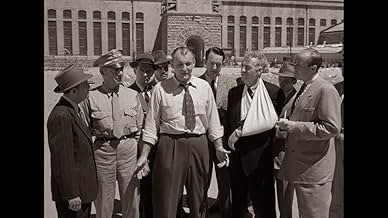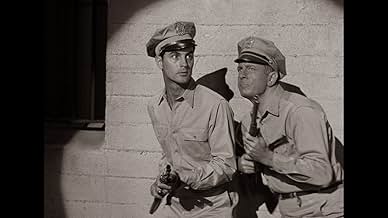Fed up with the inhumane prison living conditions, a general prison riot breaks out, leading to hostage-taking, a stand-off with the guards and eventual negotiations with the prison administ... Read allFed up with the inhumane prison living conditions, a general prison riot breaks out, leading to hostage-taking, a stand-off with the guards and eventual negotiations with the prison administration officials.Fed up with the inhumane prison living conditions, a general prison riot breaks out, leading to hostage-taking, a stand-off with the guards and eventual negotiations with the prison administration officials.
- Nominated for 2 BAFTA Awards
- 3 nominations total
Featured reviews
If I have a complaint about the movie, it would be that none of the characters are really examined deeply. I would have liked to have learned more about some of the ringleaders of the riot, as well as some of the guards. Though such deeper examinations might have made the movie much longer than the lean yet efficient eighty minute running time, and the movie might have dragged. But that's a minor problem; the movie as a whole works very well.
Cell Block 11 in this particular prison is the solitary ward, the place where the toughest cases are assigned. With a pair like Neville Brand and Leo Gordon in that block would you think otherwise.
Anyway to protest the conditions they're in the prisoners led by Brand stage a riot where they take the guards assigned to that block hostage. When Brand is wounded in a quarrel, Leo Gordon takes over leadership and he's belonging in the psycho ward. But he's the toughest guy in the joint and nobody is going to argue with him.
Emile Meyer does a great job as the warden who is a decent and compassionate individual trying to affect a few reforms. His pleas fall on deaf ears because then as now, convicts don't have any votes and by definition they are an anti-societal group. Meyer's humanity is contrasted with that of Frank Faylen who is a political appointee and tries a grandstand play with the convicts that almost gets him killed.
This is as realistic a prison drama as you will ever get. Big accolades go here to Walter Wanger who had an incredible unique perspective of life on the inside and turned it with Don Siegel's help into a great motion picture.
As far as prison pictures go - This gritty, low-budget, tough-guy tale (though mighty tame by today's standards) still packed a substantial wallop even without a non-stop barrage of profanity and bloodshed.
Filmed (in b&w) on location at Folsom State Prison, California - This particular picture is notable for being one of the first in its genre to have the disgruntled convicts manipulate the media in order to make their grievances about prison conditions known to the public.
Yes. This picture featured typical, prison stereotypes. And, yes, it contained its fair share of unintentional humour, as well - But, all the same - (With its fast-paced, 80-minute running time) - It was still well-worth a view.
"Riot In Cell Block 11" (which was produced on a $300,000 budget) was directed by Don Siegel, who would later go on to direct Clint Eastwood in 1971's Dirty Harry.
The producer Walter Wanger (known for Ford's "Stagecoach" and Hitchcock's "Foreign Correspondent") had recently been in prison for shooting his wife's lover, and his experience there motivated this production. The film was shot on location at Folsom State Prison with real inmates and guards playing background roles.
"Riot in Cell Block 11" was the first film work for Sam Peckinpah, who was hired as a third assistant casting director by Don Siegel. Wanger and Siegel would team up again two years later for "Invasion of the Body Snatchers".
The Criterion release is a must-have, with plenty of background information on those involved, the inspiration, related writings and an excellent audio commentary from a noted film historian.
The droning voice-over that opens the movie doesn't bode well: It warns of a wave of riots throughout penitentiaries across the country and even takes us to a criminal-justice convention in Toronto where the topic is aired. But soon we're inside Cell Block 11, part of a run-down, overcrowded institution whose warden (Emile Meyer) has been campaigning for reforms, to no avail. (Standing up for convicted criminals, then and now, is political suicide.) When opportunity knocks, the inmates take over the asylum. What they want is press coverage of their quite moderate demands: More elbow room, separate facilities for the mentally ill among them, job training. But they've taken guards as hostages, and threaten to execute them if their demands aren't met.
Leader of the rebels is Neville Brand, who tries to negotiate in good faith, but Meyer has one hand tied behind his back by Frank Faylen, a hard-line state bureaucrat. Brand, too, has trouble keeping the prisoners in line, particularly those who see the riot less as a cause than as a chance for some cheap thrills. Siegel manages to keep the story taut within the claustrophobic confines of the prison and without too much in the way of splashy incident, until he brings it to a surprisingly rueful end. Somehow, he has managed to make an issues movie told almost solely through action.
Siegel's career proved that he had more sides to him than he's generally known for. He started out cutting montages in other directors' movies (Blues in the Night and The Hard Way among them); when he moved into directing, his early work showed range in style and tone: The period thriller The Verdict, the light-hearted noir The Big Steal, the eschatological drama Night Unto Night. Too bad we can't remember him by saying that he just got better and better, because, unfortunately, it just isn't so.
Did you know
- TriviaLeo Gordon had served five years for armed robbery at San Quentin State Prison. For this reason, Heinze, the Folsom warden, originally objected to Gordon appearing in the film, but director Don Siegel was able to convince him that Gordon was no threat to the prison.
- GoofsWhen the state police force the convicts back into the prison by launching a barrage of tear gas at them, the police move forward, into the area being bombarded. The convicts are overcome by the gas, but the police aren't - even though they're not wearing gas masks and are enshrouded by the same gas the convicts are.
- Quotes
Warden Reynolds: I promise you no harm will come to you during this conversation. Guard! These are my instructions. Dunn is to be allowed to come into this yard and return to 11 without interference.
- Crazy creditsThe following acknowledgment appears after the opening credits: "We wish to thank Mr. Richard A. McGee and his staff of the California Department of Corrections, Warden Heinze, Associate Warden Ryan, Correctional officers and the inmates of Folsom Prison for their co-operation."
- ConnectionsEdited into Les assassins meurent aussi (1955)
- How long is Riot in Cell Block 11?Powered by Alexa
Details
Box office
- Budget
- $298,780 (estimated)
- Runtime1 hour 20 minutes
- Color
- Aspect ratio
- 1.37 : 1
Contribute to this page



































